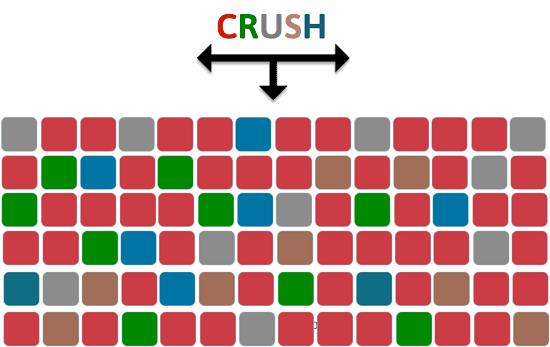Ceph: manage storage zones with CRUSH

This article introduces a simple use case for storage providers. For some reasons some customers would like to pay more for a fast storage solution and other would prefer to pay less for a reasonnable storage solution.
I. Use case
Roughly say your infrastructure could be based on several type of servers:
- storage nodes full of SSDs disks
- storage nodes full of SAS disks
- storage nodes full of SATA disks
Such handy mecanism is possible with the help of the CRUSH Map.
II. A bit about CRUSH
CRUSH stands for Controlled Replication Under Scalable Hashing:
- Pseudo-random placement algorithm
- Fast calculation, no lookup Repeatable, deterministic
- Ensures even distribution
- Stable mapping
- Limited data migration
- Rule-based configuration, rule determines data placement
- Infrastructure topology aware, the map knows the structure of your infra (nodes, racks, row, datacenter)
- Allows weighting, every OSD has a weight
For more details check the Ceph Official documentation.
III. Setup
What are we going to do?
- Retrieve the current CRUSH Map
- Decompile the CRUSH Map
- Edit it. We will add 2 buckets and 2 rulesets
- Recompile the new CRUSH Map.
- Re-inject the new CRUSH Map.
III.1. Begin
Grab your current CRUSH map:
$ ceph osd getcrushmap -o ma-crush-map |
For the sake of simplicity, let’s assume that you have 4 OSDs:
- 2 of them are SAS disks
- 2 of them are SSD enterprise
And here is the OSD tree:
$ ceph osd tree |
III.2. Default crush map
Edit your CRUSH map:
# begin crush map
# devices
device 0 osd.0
device 1 osd.1
device 2 osd.2
device 3 osd.3
# types
type 0 osd
type 1 host
type 2 rack
type 3 row
type 4 room
type 5 datacenter
type 6 pool
# buckets
host ceph-01 {
id -2 # do not change unnecessarily
# weight 3.000
alg straw
hash 0 # rjenkins1
item osd.0 weight 1.000
item osd.1 weight 1.000
}
host ceph-02 {
id -4 # do not change unnecessarily
# weight 3.000
alg straw
hash 0 # rjenkins1
item osd.2 weight 1.000
item osd.3 weight 1.000
}
rack le-rack {
id -3 # do not change unnecessarily
# weight 12.000
alg straw
hash 0 # rjenkins1
item ceph-01 weight 2.000
item ceph-02 weight 2.000
}
pool default {
id -1 # do not change unnecessarily
# weight 12.000
alg straw
hash 0 # rjenkins1
item le-rack weight 4.000
}
# rules
rule data {
ruleset 0
type replicated
min_size 1
max_size 10
step take default
step chooseleaf firstn 0 type host
step emit
}
rule metadata {
ruleset 1
type replicated
min_size 1
max_size 10
step take default
step chooseleaf firstn 0 type host
step emit
}
rule rbd {
ruleset 2
type replicated
min_size 1
max_size 10
step take default
step chooseleaf firstn 0 type host
step emit
}
# end crush map
III.3. Add buckets and rules
Now we have to add 2 new specific rules:
- one for the SSD pool
- one for the SAS pool
III.3.1. SSD Pool
Add a bucket for the pool SSD:
pool ssd {
id -5 # do not change unnecessarily
alg straw
hash 0 # rjenkins1
item osd.0 weight 1.000
item osd.1 weight 1.000
}
Add a rule for the bucket nearly created:
rule ssd {
ruleset 3
type replicated
min_size 1
max_size 10
step take ssd
step choose firstn 0 type osd
step emit
}
III.3.1. SAS Pool
Add a bucket for the pool SAS:
pool sas {
id -6 # do not change unnecessarily
alg straw
hash 0 # rjenkins1
item osd.2 weight 1.000
item osd.3 weight 1.000
}
Add a rule for the bucket nearly created:
rule sas {
ruleset 4
type replicated
min_size 1
max_size 10
step take sas
step choose firstn 0 type osd
step emit
}
Eventually recompile and inject the new CRUSH map:
$ crushtool -c ma-crush-map.txt -o ma-nouvelle-crush-map |
III.3. Create and configure the pools
Create your 2 new pools:
$ rados mkpool ssd |
Set the rule set to the pool:
ceph osd pool set ssd crush_ruleset 3 |
Check that the changes have been applied successfully:
$ ceph osd dump | grep -E 'ssd|sas' |
III.4. Test it
Just create some random files and put them into your object store:
$ dd if=/dev/zero of=ssd.pool bs=1M count=512 conv=fsync |
Where are pg active?
$ ceph osd map ssd ssd.pool.object |
CRUSH Rules! As you can see from this article CRUSH allows you to perform amazing things. The CRUSH Map could be very complex, but it brings a lot of flexibility! Happy CRUSH Mapping ;-)
Comments